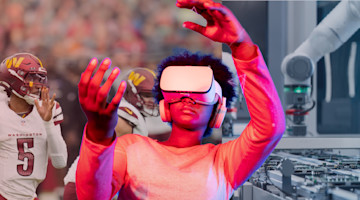The term “luddite” has come to mean anyone who is resistant to the use of new technologies, but the origin of the term dates back over two centuries to groups of mostly textile workers who would destroy machinery they saw as a threat to their jobs. While the machinery that inspired the upheaval at the beginning of the 19th century would seem unfathomably labor-intensive by today’s standards, it illustrates how the fear of new technologies replacing manufacturing jobs is not a new one. When it comes to new technology in the manufacturing sector, numerous pundits and publications paint the situation as a zero-sum tradeoff between automation and labor. In reality, the situation is far more complex, and the adoption of new technologies is far more advantageous to workers than popular perception would imply.
Unveiling a Complex Relationship: Average Machinery Value and Automation
The March 2022 edition of this column argued that the average value of machinery was a good approximation of the level of automation being deployed on factory floors. The article then looked at the overall employment level and determined that the adoption of automation tended to accelerate in times when employees were scarce. Since that article’s publication, the health of the overall labor market has markedly improved. At that point in March of 2022, there were more than two open positions available for every unemployed worker. As of February 2024, that ratio had fallen to 1.3 positions. It is important to note that this figure has fallen because of open positions being filled by people entering the workforce – not because more people became unemployed. In the same time period, nearly 6.8 million people have entered the workforce and became employed.
December 2020 was the last time the average value of machinery fell below its long-run historical average. Despite the supply and demand of labor coming closer into alignment, the average value of machinery today remains well above historical averages. Many of the supply-chain challenges present in the initial recovery after the 2020 recession have been alleviated. Demand for manufacturing technology has moderated, with the value of new orders declining 6.2% in 2022 and 11.4% in 2023 after reaching a record-setting level in 2021. The persistently high average value of machinery now undoubtedly reflects the increased quality and ubiquity of automation in new machinery orders.
Manufacturing Employment: Tracing the Impact of Automation on Job Trends
While a luddite or someone sympathetic to their philosophy may point out that just because overall employment improved at the same time automation increased, employment gains may have come from sectors of the economy where automation wasn’t deployed. There is a historical basis for this concern, as seen from August 2015 to November 2016, when manufacturing employment declined by 7,000 jobs while the whole economy added 3.2 million jobs.
Fortunately, those worries may be assuaged, as employment among durable goods manufacturers, the companies most likely to utilize metal working machinery, has increased nearly 8% since January 2021. Examining the trend further back, there is a moderately positive correlation between the average machine value and employment among durable goods manufacturers. The correlation is much stronger than the one between total value and employment, implying that the sophistication of the machinery matters more than sheer volume alone.
Embracing the Future: Beyond Luddite Fears
While there have been many transformative economic events in the last few years, the replacement of workers through increased automation is not quite the story that has been made popular. As with many advances in technology, fear often takes hold before understanding, and opportunity is squandered. Looking to the future and embracing new technologies seems like the logical route to take, but that may not be as natural to us as it is to long for the past. Just ask a luddite – even if that means pulling out a quill and parchment instead of sending an email.
To read the rest of the Automation & Robotics Issue of MT Magazine, click here.






